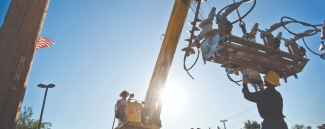Power outages in the U.S. are on the rise, according to a report by Climate Central, a nonprofit research group, as extreme weather events happen more frequently, demand for electricity rises and our aging energy infrastructure becomes more vulnerable. In fact, power outages have increased 64% over the previous decade in the country.
To combat these problems, the PEER rating system was developed. PEER measures and improves power system performance and electricity infrastructure. Through the techniques prioritized in the rating system, campuses, microgrids, utilities, transportation systems and other major infrastructure elements find new ways to boost their reliability and resilience in the face of increasing global challenges.
Check out some of the top ways PEER helps projects prepare for the worst:
1. PEER-certified power systems are “hardened” to protect from external threats, such as falling trees, flooding and earthquakes.
Grid hardening is an end-to-end approach that better protects infrastructure and improves service levels in extreme weather.
Key PEER credit: Reliability and Resiliency (RR) credit: Damage and Exposure Prevention—Option 1—External Damage Prevention.
2. PEER-certified projects are encouraged to have on-site, back-up power sources that can supply critical services during a utility failure.
Backup sources ensure power for critical loads and essential services during emergencies, as well as supporting community recovery after catastrophic events and power grid outages.
Key PEER credits: RR credits: Alternative Source of Supply; Power Surety and Resilience.
3. PEER-certified projects have multiple power distribution pathways with enough redundancy to ensure resilience, even if a section of the distribution network fails.
Redundancy is a key strategy to improve reliability and resilience; it ensures that the grid’s power can be supplied by multiple sources to account for a number of potential failure points.
Key PEER credit: RR credit: Distribution Redundancy and Auto Restoration.
4. PEER-certified projects continuously monitor the power distribution network for disruptions, finding and resolving them quickly.
By monitoring a distribution network, operators and customers have greater transparency on interruption duration and frequency to understand patterns and make adjustments for better performance.
Key PEER credit: RR credit: Reliability Performance Monitoring.
5. PEER-certified projects develop emergency preparedness plans and staff training based on comprehensive risk assessment, which enables them to bounce back quickly after an event.
PEER projects create a comprehensive risk assessment for critical assets within the project boundary, using the risk matrix approach described in the PEER Reference Guide.
Key PEER credit: Operations, Management and Safety credit: Emergency Response Planning; Risk Assessment and Mitigation.
PEER is here to help power systems prepare for the challenges and opportunities of the 21st century. See if your project could be a good fit.
